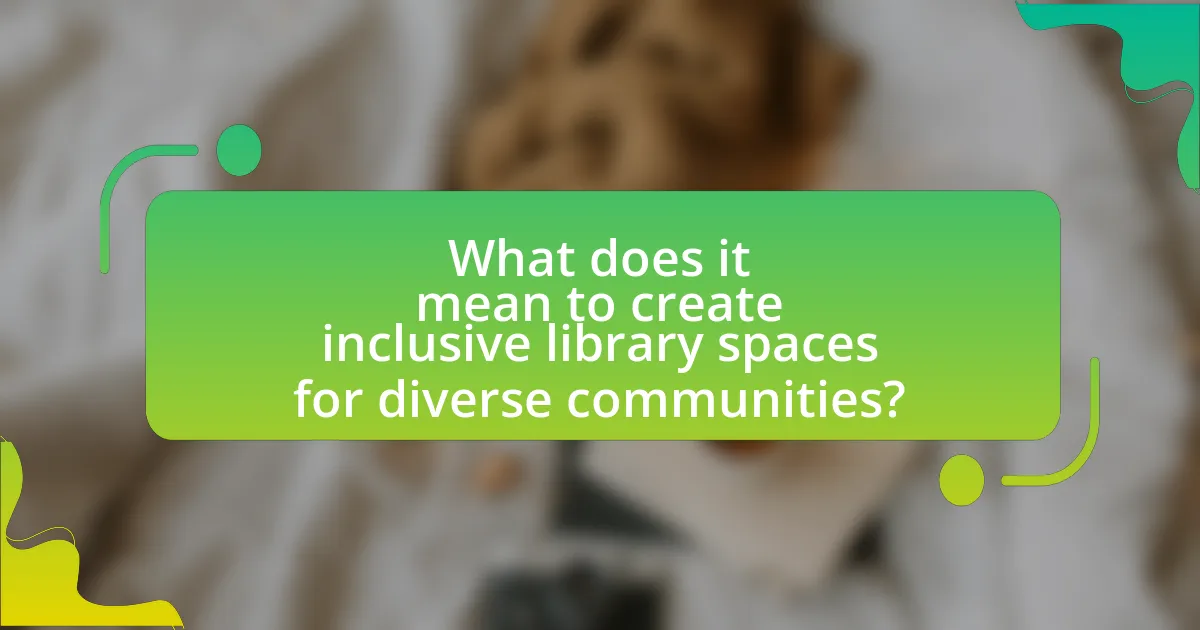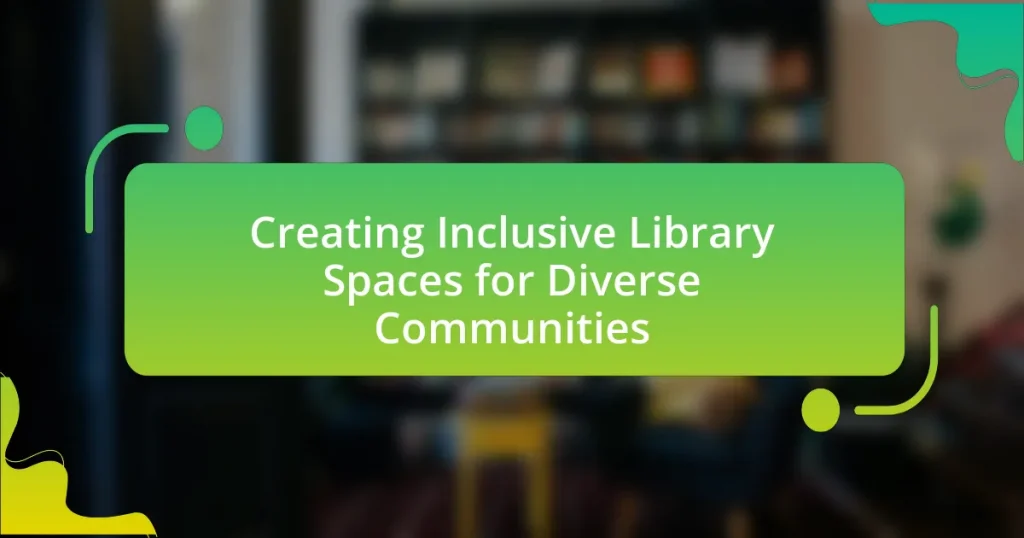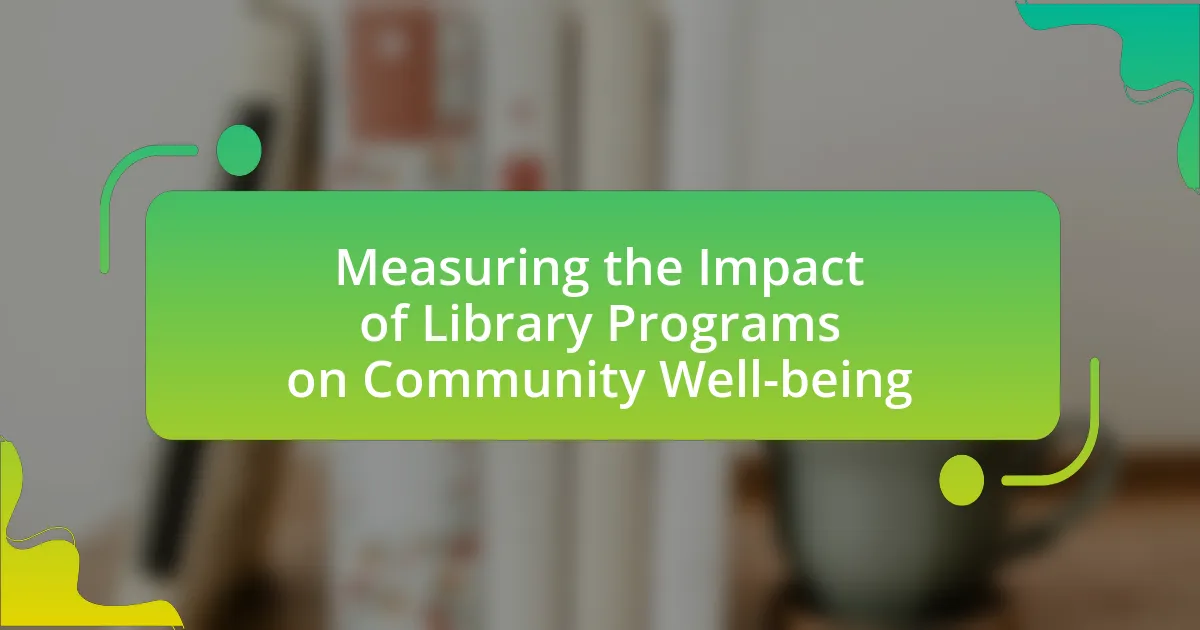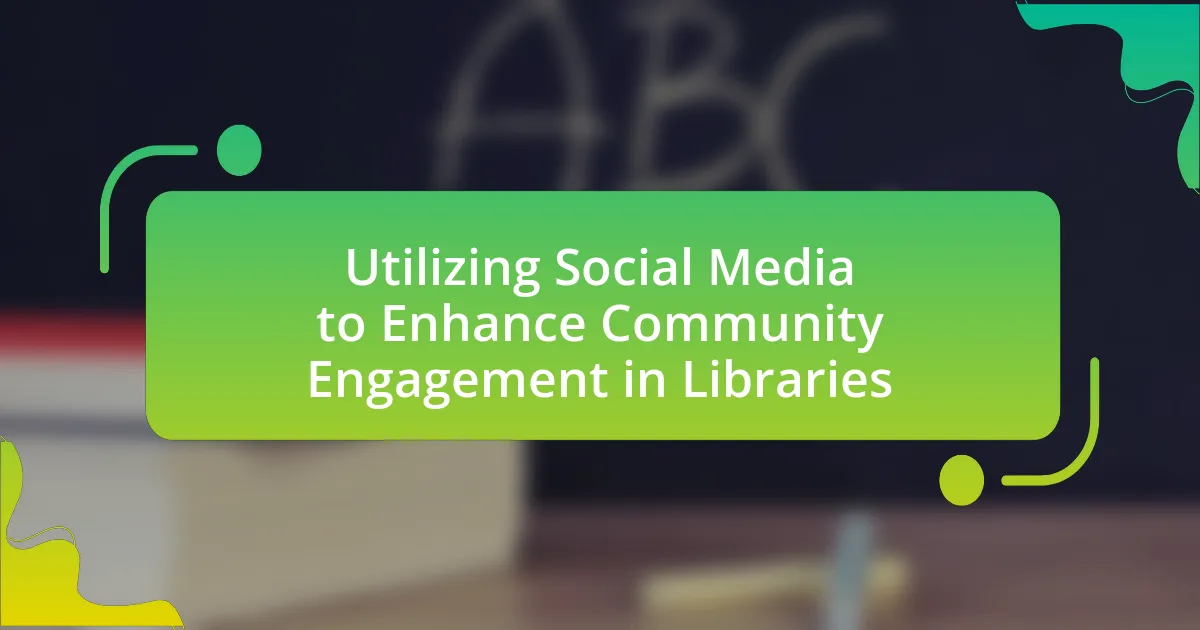Creating inclusive library spaces for diverse communities involves designing environments that welcome individuals from various backgrounds, cultures, and abilities. Key elements include ensuring accessibility, providing diverse materials, and fostering community engagement through tailored programs. The article explores the importance of inclusivity in libraries, its impact on community engagement, and the consequences of non-inclusive environments. It also outlines strategies for effective implementation of inclusive practices, the challenges libraries face, and best practices for maintaining inclusivity, emphasizing the role of technology and community feedback in enhancing library services.

What does it mean to create inclusive library spaces for diverse communities?
Creating inclusive library spaces for diverse communities means designing environments that welcome and serve individuals from various backgrounds, cultures, and abilities. This involves ensuring accessibility, providing diverse materials that reflect the community’s demographics, and fostering programs that engage different groups. For instance, libraries can implement wheelchair-accessible facilities, offer multilingual resources, and host events that celebrate cultural diversity, thereby promoting equity and participation. Research indicates that inclusive library practices enhance community engagement and improve information access for marginalized populations, demonstrating the importance of such initiatives in fostering a sense of belonging and support within the community.
Why is inclusivity important in library spaces?
Inclusivity is important in library spaces because it ensures that all individuals, regardless of their background, have equal access to resources and services. Libraries serve as community hubs that reflect the diversity of the populations they serve; therefore, inclusive practices foster a welcoming environment that encourages participation from various demographic groups. Research indicates that inclusive library spaces enhance user engagement and satisfaction, as they provide tailored services that meet the unique needs of different communities. For instance, the American Library Association emphasizes that inclusivity in libraries promotes social equity and supports the educational and informational needs of all patrons, ultimately enriching the community as a whole.
How does inclusivity impact community engagement in libraries?
Inclusivity significantly enhances community engagement in libraries by fostering a welcoming environment for diverse populations. When libraries implement inclusive practices, such as providing materials in multiple languages and hosting culturally relevant programs, they attract a broader audience. Research indicates that libraries that prioritize inclusivity see increased participation in events and services, as evidenced by a study from the American Library Association, which found that 75% of libraries reported higher community involvement after adopting inclusive policies. This engagement not only enriches the library’s offerings but also strengthens community ties and promotes a sense of belonging among all patrons.
What are the consequences of non-inclusive library environments?
Non-inclusive library environments lead to decreased access to resources and services for marginalized groups. This exclusion can result in lower literacy rates and reduced educational opportunities among these communities. Research indicates that libraries that do not prioritize inclusivity often fail to meet the diverse needs of their patrons, which can perpetuate social inequalities. For instance, a study by the American Library Association found that libraries lacking inclusive practices see a significant drop in usage among underrepresented populations, highlighting the direct impact of non-inclusivity on community engagement and resource utilization.
What are the key elements of inclusive library design?
The key elements of inclusive library design include accessibility, diverse collections, community engagement, and flexible spaces. Accessibility ensures that all individuals, regardless of physical ability, can navigate the library easily; this includes features like ramps, elevators, and accessible restrooms. Diverse collections reflect the varied backgrounds and interests of the community, providing materials in multiple languages and formats to cater to different needs. Community engagement involves actively seeking input from diverse groups to inform library services and programs, ensuring that the library meets the specific needs of its users. Flexible spaces allow for a variety of activities, accommodating both quiet study and collaborative work, which supports a range of learning styles and community events. These elements collectively foster an environment where all community members feel welcome and valued.
How can physical space be optimized for inclusivity?
Physical space can be optimized for inclusivity by ensuring accessibility, flexibility, and diverse resource availability. Accessibility involves designing spaces that accommodate individuals with disabilities, such as wheelchair ramps, accessible restrooms, and clear signage. Flexibility can be achieved through movable furniture and adaptable layouts that cater to various group sizes and activities. Additionally, providing diverse resources, including multilingual materials and culturally relevant programming, fosters an inclusive environment. Research indicates that libraries that prioritize these elements see increased community engagement and satisfaction, demonstrating the effectiveness of inclusive design principles.
What role does technology play in creating inclusive library spaces?
Technology plays a crucial role in creating inclusive library spaces by providing accessible resources and services that cater to diverse community needs. For instance, assistive technologies such as screen readers, magnifiers, and adaptive software enable individuals with disabilities to access information and participate fully in library programs. Additionally, digital platforms facilitate remote access to library services, allowing users from various backgrounds, including those with mobility challenges or those living in remote areas, to engage with library resources. Research indicates that libraries implementing technology-driven inclusivity measures see increased patron engagement and satisfaction, highlighting the effectiveness of these tools in fostering an inclusive environment.
Who are the diverse communities that libraries serve?
Libraries serve a variety of diverse communities, including racial and ethnic minorities, individuals with disabilities, LGBTQ+ individuals, immigrants, refugees, and low-income populations. These communities often seek access to resources, information, and services that reflect their unique needs and experiences. For instance, according to the American Library Association, libraries play a crucial role in providing culturally relevant materials and programs that support literacy and education for these groups, thereby fostering inclusivity and community engagement.
What specific needs do different communities have in library spaces?
Different communities have specific needs in library spaces that cater to their unique cultural, educational, and social requirements. For instance, immigrant communities often require multilingual resources and spaces for language learning, while marginalized groups may seek safe environments for community gatherings and support services. Additionally, children and youth need dedicated areas for study and creative activities, while seniors benefit from accessible technology and programming tailored to their interests. Research indicates that libraries that adapt to these diverse needs enhance community engagement and promote inclusivity, as evidenced by the American Library Association’s findings on the importance of responsive library services in fostering equitable access to information and resources.
How can libraries identify and understand their diverse user base?
Libraries can identify and understand their diverse user base by conducting surveys, analyzing usage data, and engaging with community outreach programs. Surveys can gather demographic information and user preferences, while usage data reveals patterns in borrowing and program attendance. Community outreach programs allow libraries to connect directly with various groups, fostering relationships and gaining insights into their specific needs and interests. For instance, a study by the American Library Association found that libraries that actively engage with their communities see increased participation from underrepresented groups, demonstrating the effectiveness of these methods in understanding diverse user bases.
How can libraries implement inclusive practices effectively?
Libraries can implement inclusive practices effectively by actively engaging with diverse community members to understand their needs and preferences. This engagement can include conducting surveys, hosting focus groups, and collaborating with local organizations that represent marginalized populations. For instance, a study by the American Library Association found that libraries that tailored their services based on community feedback saw a 30% increase in participation from underrepresented groups. Additionally, libraries should ensure their collections reflect diverse voices and perspectives, which can be achieved by diversifying acquisition policies and including materials in multiple languages. By creating accessible physical spaces and offering programs that cater to various cultural backgrounds, libraries can foster an environment where all community members feel welcomed and valued.
What training is necessary for library staff to promote inclusivity?
Library staff should undergo training in cultural competency, diversity awareness, and inclusive service practices to effectively promote inclusivity. This training equips staff with the skills to understand and respect diverse backgrounds, including race, ethnicity, gender identity, sexual orientation, and abilities. Research indicates that libraries that implement such training see improved interactions with patrons from various communities, fostering a welcoming environment. For instance, the American Library Association emphasizes the importance of ongoing professional development in these areas to enhance service delivery and community engagement.
How can libraries engage with community members to foster inclusivity?
Libraries can engage with community members to foster inclusivity by implementing programs that reflect the diverse needs and interests of the community. For instance, libraries can host multicultural events, workshops, and book clubs that celebrate various cultures and languages, thereby encouraging participation from underrepresented groups. Research indicates that libraries that actively involve community members in program planning see increased attendance and engagement, as evidenced by a study from the American Library Association which found that 75% of libraries reported enhanced community relationships through inclusive programming. Additionally, libraries can create accessible spaces and resources, such as providing materials in multiple languages and ensuring physical accessibility, which further supports inclusivity and invites broader community participation.

What challenges do libraries face in creating inclusive spaces?
Libraries face significant challenges in creating inclusive spaces, primarily due to limited funding and resources. Many libraries operate under tight budgets, which restrict their ability to implement necessary changes, such as renovating facilities to accommodate individuals with disabilities or providing diverse materials that reflect various cultures and languages. According to the American Library Association, 63% of libraries report insufficient funding as a barrier to meeting the needs of diverse communities. Additionally, staff training on cultural competency and inclusivity is often lacking, which can hinder the ability to serve all patrons effectively. These factors collectively impede libraries from fully realizing their potential as inclusive community hubs.
What are common barriers to inclusivity in library environments?
Common barriers to inclusivity in library environments include physical accessibility issues, lack of diverse materials, and insufficient staff training on cultural competency. Physical accessibility issues, such as inadequate ramps or signage, hinder individuals with disabilities from fully utilizing library services. The absence of diverse materials fails to represent the varied backgrounds of the community, limiting engagement from underrepresented groups. Additionally, insufficient staff training on cultural competency can lead to misunderstandings and a lack of support for patrons from diverse backgrounds, further alienating them from library resources. These barriers collectively impede the goal of creating inclusive library spaces for all community members.
How can budget constraints affect inclusivity efforts?
Budget constraints can significantly hinder inclusivity efforts by limiting resources available for programs, services, and facilities that cater to diverse communities. When libraries face financial limitations, they may reduce funding for outreach initiatives, staff training on inclusivity, or the acquisition of diverse materials, which are essential for creating welcoming environments. For instance, a study by the American Library Association found that libraries with higher budgets are more likely to implement programs that support marginalized groups, demonstrating a direct correlation between funding and the effectiveness of inclusivity efforts.
What resistance might libraries encounter when implementing inclusive practices?
Libraries might encounter resistance from staff and patrons when implementing inclusive practices. This resistance can stem from a lack of understanding or awareness of the importance of inclusivity, leading to reluctance in adopting new policies or practices. Additionally, some staff may feel threatened by changes to traditional roles or fear that inclusivity efforts could dilute the library’s mission. Research indicates that 70% of library staff reported feeling unprepared to address diversity issues, highlighting a significant gap in training and education. Furthermore, patrons may resist changes due to preconceived notions about inclusivity, fearing it may prioritize certain groups over others. This resistance can hinder the successful implementation of inclusive practices, making it essential for libraries to provide education and resources to foster a more inclusive environment.
How can libraries overcome these challenges?
Libraries can overcome challenges in creating inclusive spaces by implementing targeted outreach programs and diversifying their collections. Targeted outreach programs, such as partnerships with local community organizations, can help libraries engage underrepresented groups and understand their specific needs. Diversifying collections to include materials that reflect various cultures, languages, and perspectives ensures that all community members feel represented and valued. Research indicates that libraries that actively seek input from diverse populations see increased usage and satisfaction, demonstrating the effectiveness of these strategies in fostering inclusivity.
What strategies can be employed to secure funding for inclusivity initiatives?
To secure funding for inclusivity initiatives, organizations can employ strategies such as building partnerships with local businesses and community organizations, applying for grants specifically aimed at diversity and inclusion, and engaging in crowdfunding campaigns. Partnerships can leverage shared resources and enhance visibility, while grants from foundations like the Ford Foundation or the Knight Foundation provide financial support for projects that promote inclusivity. Crowdfunding platforms, such as GoFundMe or Kickstarter, allow for community engagement and can generate funds through small contributions from a large number of supporters. These strategies have been effective in various initiatives, demonstrating their potential to attract necessary funding for creating inclusive library spaces for diverse communities.
How can libraries build partnerships to enhance inclusivity?
Libraries can build partnerships to enhance inclusivity by collaborating with local organizations, schools, and community groups that represent diverse populations. These partnerships enable libraries to co-create programs and services that address the specific needs of underrepresented communities, such as language classes, cultural events, and access to technology. For instance, a partnership with a local immigrant support organization can lead to tailored resources and workshops that help newcomers integrate into the community. Research shows that libraries that actively engage with diverse stakeholders see increased participation and satisfaction among marginalized groups, thereby fostering a more inclusive environment.

What are the best practices for maintaining inclusive library spaces?
The best practices for maintaining inclusive library spaces include ensuring accessibility, promoting diverse collections, and fostering community engagement. Accessibility involves providing physical accommodations such as ramps, elevators, and accessible restrooms, which are essential for individuals with disabilities. Diverse collections should reflect various cultures, languages, and perspectives, allowing all community members to see themselves represented in library resources. Community engagement can be achieved through outreach programs, events, and partnerships with local organizations, which help libraries understand and meet the specific needs of their diverse populations. These practices are supported by research indicating that inclusive environments enhance user satisfaction and participation in library services.
How can libraries continuously assess their inclusivity efforts?
Libraries can continuously assess their inclusivity efforts by implementing regular surveys and feedback mechanisms that gather input from diverse community members. These assessments can include quantitative measures, such as demographic data analysis, and qualitative feedback through focus groups or interviews, allowing libraries to identify gaps in services and resources. For instance, a study by the American Library Association found that libraries that actively engage with their communities through outreach programs and feedback initiatives are more successful in meeting the needs of diverse populations. This ongoing evaluation process enables libraries to adapt their services and programs to better serve all community members, ensuring that inclusivity remains a priority.
What metrics can be used to evaluate the effectiveness of inclusivity initiatives?
Metrics to evaluate the effectiveness of inclusivity initiatives include participation rates, user satisfaction surveys, demographic representation, and accessibility assessments. Participation rates measure the number of diverse individuals engaging with library services, indicating the reach of inclusivity efforts. User satisfaction surveys provide qualitative feedback on the experiences of various community members, highlighting areas for improvement. Demographic representation assesses whether the library’s user base reflects the diversity of the community it serves, which is crucial for understanding inclusivity impact. Accessibility assessments evaluate physical and digital access to library resources, ensuring that all community members can utilize services effectively. These metrics collectively provide a comprehensive view of how well inclusivity initiatives are functioning within library spaces.
How can feedback from community members shape library practices?
Feedback from community members can significantly shape library practices by informing the development of services, programs, and resources that meet the specific needs of diverse populations. Libraries that actively solicit and incorporate community input can identify gaps in their offerings, ensuring that they are relevant and accessible. For instance, a study by the American Library Association found that libraries that engage with their communities through surveys and focus groups are more likely to implement programs that reflect the interests and needs of those they serve, leading to increased patron satisfaction and usage. This direct connection between community feedback and library practices fosters an inclusive environment that values diverse perspectives and promotes equitable access to information and resources.
What resources are available for libraries seeking to improve inclusivity?
Libraries seeking to improve inclusivity can access a variety of resources, including the American Library Association’s (ALA) guidelines on diversity and inclusion, which provide frameworks for creating welcoming environments. Additionally, the ALA offers training programs and workshops focused on cultural competency and inclusive practices. The “Inclusive Services Assessment Tool” developed by the ALA helps libraries evaluate their current inclusivity efforts and identify areas for improvement. Furthermore, partnerships with local community organizations can enhance outreach and engagement with diverse populations, ensuring that library services meet the needs of all community members.
What organizations provide support and guidance for inclusive library practices?
Organizations that provide support and guidance for inclusive library practices include the American Library Association (ALA), the Association of College and Research Libraries (ACRL), and the International Federation of Library Associations and Institutions (IFLA). The ALA offers resources and guidelines specifically aimed at promoting diversity and inclusion within library services, while the ACRL focuses on academic libraries and their role in fostering inclusive environments. IFLA provides a global perspective on library practices, emphasizing the importance of inclusivity in library services worldwide. These organizations are recognized for their commitment to advancing inclusive practices in libraries, supported by their extensive resources and advocacy efforts.
How can libraries access training and development opportunities for staff?
Libraries can access training and development opportunities for staff through partnerships with educational institutions, professional organizations, and online platforms. These collaborations often provide workshops, webinars, and certification programs tailored to library staff needs. For instance, the American Library Association offers various resources and training programs that focus on inclusivity and diversity, which are essential for creating inclusive library spaces. Additionally, many libraries utilize platforms like Coursera and LinkedIn Learning to provide staff with access to a wide range of courses that enhance their skills and knowledge in serving diverse communities.
What practical steps can libraries take to enhance inclusivity today?
Libraries can enhance inclusivity today by implementing targeted outreach programs that engage underrepresented communities. These programs can include multilingual services, partnerships with local organizations, and tailored events that reflect the diverse cultural backgrounds of the community. For instance, a study by the American Library Association found that libraries that actively promote diverse programming see increased participation from marginalized groups, demonstrating the effectiveness of such initiatives. Additionally, libraries can assess their collections to ensure they include materials that represent various perspectives, thereby fostering a more inclusive environment.






